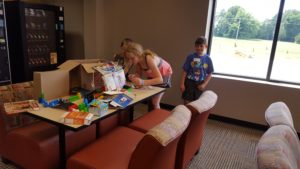William Penn University’s Importance of STEM in Education

Computer Camp attendees designed race tracks for their hexbugs to follow to a determined location
while meeting all of the constraints.
(Photo provided by Breanne Garrett, Computer Camp 2017)
(OSKALOOSA, Iowa) — STEM (Science, Technology, Engineering, and Mathematics) has been an area of focus for education and business over the last decade. What has been an even greater focus is including STEM practices in early education and beyond. William Penn University’s own Assistant Teaching Professor of Mathematics, Breanne Garrett, has been highly devoted to the investment of mathematics to people of all ages and skill levels.
In addition to her profession duties at William Penn, Garrett serves on the South Central STEM Advisory Board for Iowa. Sitting on this board allows Garrett to make decisions about funding STEM initiatives and recognizing the outstanding STEM teachers in the south central Iowa area. Through this, she learns of potential opportunities for Iowa students and has hosted booths at STEM festivals.
Most recently, Sarah Derry with Drake University and the South Central STEM hub manager, held a teacher training event in the Penn Activity Center on Friday, July 13, 2018. This training on the Oskaloosa William Penn campus involved elementary teachers who were awarded Scale-Up grants for STEM in Action. Representatives from ETA hand2mind—a company that produces STEM in Action kits—attended the training and, in conjunction with Garrett, provided best practices, data, and opportunities for the teachers in attendance.
“STEM is important to today’s society,” said Garrett. Many of the career fields that are facing a worker shortage of qualified employees are in the STEM fields—that is expected to grow in the future, Garrett states. “It’s crucial for students to gain some type of real work experience before graduating high school,” said Garrett, “because it can often lead them to employment, either directly after graduation or after some post-secondary training.”
At William Penn University, many of the students in the Applied Technology Division and Digital Communication Program are getting as much on-the-job and real-world job experience while still taking courses. This training encompasses field trips, guest speakers, or even internships.
“We are lucky to have an Industrial Technology Department that allows students to complete a more in-depth 4-year degree in a field that is often only found at community colleges,” said Garrett. In addition to STEM education at Penn, Garrett feels by adopting the STREAM model it has allowed Penn students to learn even more in the classrooms. “While most argue that Relationship (R) building and creative Arts (A) are already embedded in the STEM movement,” Garrett said, “placing them alongside Science, Technology, Engineering, and Mathematics emphasizes the truth that our students need to be able to effectively communicate with others and build those relationships needed to be successful.”
Providing opportunities, educating the future, and further developing STEM education is something that Garrett is passionate about. She continues to work with upper elementary teachers, as she knows that time frame is a critical time in a child’s life where interest in STEM decreases. Garrett states that girls and some minorities shy away from STEM, but by having teachers increasing engagement they can encourage these populations to grow and get involved with STEM.
There are a multitude of elements that teachers can actively do to promote growth in interest of STEM. “Things like providing role models, encouragement, higher expectations, and showcasing how STEM can solve problems that are for the social good,” said Garrett.
Garrett’s involvement with STEM and mathematics education far exceeds the classrooms at Penn. She is part of the State Mathematics Leadership Team, Iowa Math Teacher Educators, Mathematical Association of America and the Iowa section, and a Member of the Iowa Council of Teachers of Mathematics. Garrett likes to use a variation of Inquiry Based Learning, Japanese Lesson Study, and strives to provide curriculum relevant to current students.
For more information about Applied Mathematics under the Applied Technology Division, visit www.wmpenn.edu/applied-technology.










